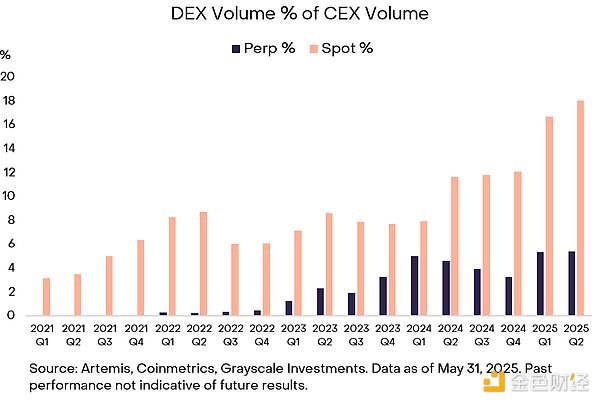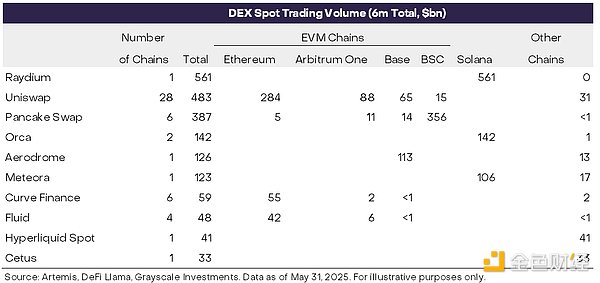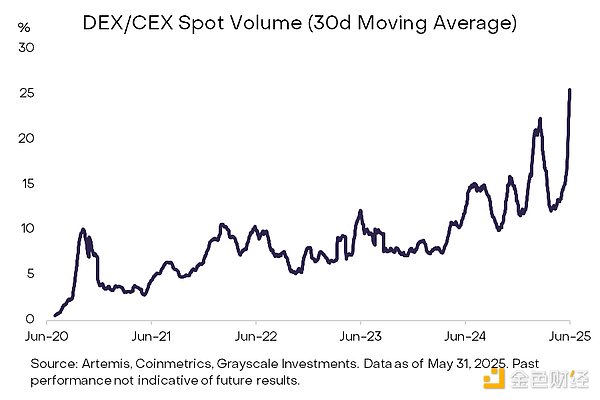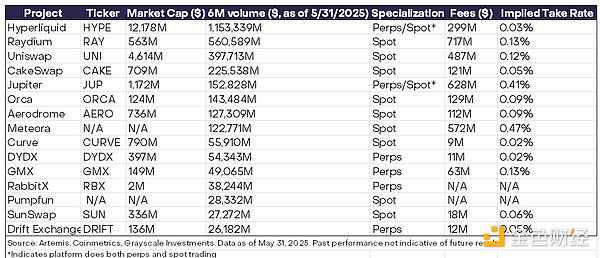Author: Michael Zhao & Zach Pandl, Grayscale; Translation: Golden Finance xiaozou
Just like in traditional finance, exchanges are core infrastructure in the digital asset industry. Although decentralized exchanges (DEX) are currently mainly focused on crypto asset trading, the share of trading volume of stablecoins and tokenized assets is expected to continue to grow over time.
Currently, cryptocurrency trading is still dominated by centralized exchanges (CEX), which adopt traditional enterprise architecture. But the industry is increasingly "reaping the fruits of its own labor": more and more trading volume is shifting to decentralized exchanges (DEX), as evidenced by the explosive growth of decentralized futures exchange Hyperliquid this year.
Decentralized exchanges (DEXs) settle trades on-chain without the need for a centralized operator - in the form of smart contract applications deployed on blockchains such as Ethereum or Solana, or exchange logic embedded directly in Layer 1 protocols such as Hyperliquid. In the first five months of 2025, DEXs accounted for 7.6% of total cryptocurrency trading volume.
While cryptocurrency exchanges can benefit from increased trading volume, they also face competitive pressure in terms of transaction fees. Grayscale Research expects that CEXs will continue to dominate trading of large-cap assets such as Bitcoin, but DEXs will become the preferred choice for trading long-tail assets and for users who value the transparency and accessibility of a permissionless global platform.
Public blockchains provide digital commerce solutions without centralized intermediaries. However, to attract users, decentralized technologies must provide features that are at least as attractive as centralized solutions. If decentralized applications are inferior to centralized solutions in terms of speed, cost, and historical data, then blockchain activity is likely to remain a small part of the online business landscape.
Fortunately, after several years of exploration, we have seen decentralized applications compete head-on with traditional institutions in the core area of cryptocurrency: token trading. Grayscale Research estimates that DEXs currently account for 7.6% of total global cryptocurrency trading volume (only 3% in 2023), and their share of trading volume relative to CEXs has also increased significantly (Figure 1). Today, DEXs are on par with CEXs in terms of price, are often more transparent, and are often the main trading venue for newly issued assets on the chain.
Figure 1: DEX trading volume has more than doubled relative to CEX since 2021

This year is likely to be a turning point for the industry, as technological advances and regulatory clarity will drive user adoption of DEX and other decentralized financial (DeFi) applications. This article will provide a comprehensive overview of the DEX industry, including industry structure, competitive situation, and development prospects. Grayscale Research believes that market leadership will eventually be concentrated in a few leading platforms - there may be only one or two exchanges in each segment (CEX vs. DEX, spot vs. perpetual contracts) - which combine deep liquidity, capital-efficient infrastructure with attractive token or equity economic models.
1. How to trade tokens
In traditional finance (TradFi), transactions are executed through exchanges or over-the-counter markets (OTC) after the two parties reach a consensus on the price. These transactions are matched through a central limit order book (CLOB) or a broker network. After the transaction is executed, a clearing house such as the Depository Trust Company (DTC) confirms the transaction details, the risk exposure of the netting participants, and completes the settlement (electronic record of the transfer of funds and securities ownership) the next day. Equity securities will be settled from T+2 to T+1 in May 2024.
Cryptocurrency trading uses a completely different market structure, which can be divided into three categories: trading venues, exchange architecture and trading products.
Cryptocurrency trading venues are mainly divided into two categories:
Centralized Exchanges (CEX): Traditional commercial institutions that use off-chain custody and trade matching to provide a near-instant settlement experience through internal ledgers. However, users will still experience settlement delays when transferring assets out to traditional bank accounts.
Decentralized Exchanges (DEX): Smart contract applications deployed directly on blockchains (such as Ethereum) that allow users to trade directly from self-hosted wallets. When trading on a DEX, execution and settlement are completed within a single block confirmation cycle, which usually takes only seconds.
DEX mainly adopts two trading architectures:
Automated Market Maker (AMM):Passively provides quotes through liquidity pools, based on preset mathematical curves (such as the constant product formula x*y=k) or the centralized liquidity model of Uniswap v3. AMM is particularly good at efficiently handling long-tail asset exchanges and stablecoin transactions, and performs well on blockchains with limited throughput.
Central Limit Order Book (CLOB):Highly restores the traditional exchange model, matching through limit orders dynamically managed by liquidity providers. This method usually achieves narrower spreads and higher capital efficiency, and is particularly suitable for high-volume assets and perpetual contracts. However, maintaining this efficiency requires frequent order updates and relies on complex infrastructure such as professional blockchain application chains or Roll-ups.
Both CEX and DEX support two types of product transactions:
Spot trading:The underlying token is delivered immediately at the agreed price - no leverage, only on-chain transfers (or CEX internal ledger updates).
Perpetual contracts (Perps):Derivative contracts with no expiration date, tracking the price of the underlying asset, settled through margin adjustments and funding rate payments, and support leveraged trading.
2. Business model of exchanges
Exchanges make profits by charging transaction fees. In the crypto space, CEXs charge fees directly, while DEXs usually distribute fees to liquidity providers, token holders, and/or protocol vaults through smart contract mechanisms or governance decisions.
Currently, DEX has fully achieved price competitiveness against CEX. Based on data from the first five months of 2025, Grayscale Research estimates that the weighted average transaction fee for CEX spot trading volume is about 15 bps, while that for DEX is 12 bps; the average transaction fee for CEX perpetual contracts is 4 bps, while that for DEX is 6 bps (Figure 2). Although these data do not reflect the differences in fees between platforms and tokens, they show that the average transaction fees of the two types of platforms have become equal.
Figure 2: DEX is now as price competitive as CEX

As the cryptocurrency industry grows, all exchanges are likely to benefit from increased trading volume, but will also face pressure to reduce fees. Although the fees of CEX and DEX are now close, compared to the most efficient markets in traditional finance, cryptocurrency trading fees are still high. For example, academic research has found that the average fee for US stock exchanges is only 0.0001% (one ten-thousandth of a basis point). It will take time for cryptocurrency trading to reach such low levels, but fierce competition from traditional exchanges does suggest that cryptocurrency trading fees will inevitably fall as market competition intensifies.
In the long run, we expect cryptocurrency exchanges to have more consistent capital structures. As traditional companies, CEXs are usually funded through equity (such as Coinbase), but may also issue associated tokens (such as BNB). DEXs are smart contracts based on open source software and operate without any controlling party. However, the development teams behind them may be funded through equity, tokens, or a combination of both. Tokens may provide various benefits to holders, but there is no uniform model across projects: DEX tokens may capture cash flow, provide governance rights, or simply have marketing and branding value (Figure 3). It is important to note that token models can and do change through governance; Uniswap's UNI token has explored proposals such as turning on a fee switch for stakers (a fee allocation switch controlled by governance), which could reshape the value proposition of the token overnight. Therefore, investing in DEX tokens requires a deep understanding of the project's economic model, governance proposals, and token supply and value accumulation mechanisms.
Figure 3: The economic models of DEX tokens vary significantly

3. The evolution of decentralized exchanges
The development of decentralized exchanges has shown obvious staged breakthroughs, and each generation has overcome the limitations of the previous generation. Early attempts (2017-2018) - such as EtherDelta's order book model, 0x protocol's off-chain relay solution, and Bancor's pioneering AMM pool - verified the feasibility of decentralized trading, but faced serious user experience and liquidity challenges. The launch of Uniswap in 2018 became a turning point. Its simplified AMM model and intuitive interface greatly improved accessibility and paved the way for the explosive growth of trading volume and total locked value during the "Summer of DeFi" in 2020.
Further optimizations from 2021 to 2023 - especially the centralized liquidity design of Uniswap v3, and the innovations of Perpetual Protocol and GMX in the field of perpetual contracts - significantly improved capital efficiency and enabled more sophisticated on-chain derivatives trading. In the recent stage (2023-2025), on-chain CLOBs such as Cosmos-based dYdX Layer1 and Hyperliquid's ultra-high-speed custom blockchain have emerged one after another, combining the speed and accuracy of centralized exchanges with the transparent and decentralized characteristics of DeFi.
The current average daily trading volume (ADV) of spot and perpetual contracts on cryptocurrency DEXs is close to US$10 billion (Figure 4), while the average daily trading volume of the New York Stock Exchange Group's platform is about US$150 billion. The growth in DEX perpetual contract trading volume mainly comes from Hyperliquid, which accounts for about 80% of the total average daily trading volume of perpetual contracts.
Figure 4: The average daily trading volume of DEX spot and perpetual contracts has exceeded 10 billion US dollars

A unique feature of cryptocurrency trading is that some spot DEXs are deeply bound to specific blockchain ecosystems such as Ethereum or Solana. For example, Figure 5 shows the distribution of DEX spot trading volume on various blockchains in the past six months - the industry leader Raydium is only deployed on the Solana chain, while Uniswap's AMM model has expanded to 28 different chains. Therefore, for crypto spot DEXs, changes in trading volume are often closely related to fluctuations in economic activities of the blockchain ecosystem to which they belong.
Figure 5: Spot DEX can achieve multi-protocol deployment

4. DEX market share expansion
Currently, DEX has occupied about 25% of the trading volume in the cryptocurrency spot market. Decentralized exchanges can continue to seize market share, mainly due to the rapid innovation of their product supply side. DEX often takes the lead in launching new tokens, attracting early liquidity and speculative trading volume. For example, during the on-chain ecosystem explosion at the end of 2024, many popular crypto narratives, such as AI-themed tokens on Solana and Base chains, and viral tokens such as the TRUMP meme coin on Meteora, were initially born only in the decentralized liquidity pools of chains such as Solana and Base. These new tokens were not listed on centralized exchanges in the early stages, prompting traders to interact directly with decentralized platforms.
Figure 6: The ratio of DEX to CEX spot trading volume continues to rise

Decentralized exchanges have also made significant progress in the field of perpetual contract trading - this is mainly due to the explosive success of the decentralized perpetual contract exchange Hyperliquid. Grayscale Research estimates that in the past 30 days ending May 31, 2025, DEX perpetual contract trading volume accounted for approximately 5.4% of CEX perpetual contract trading volume (Figure 7). Even so, centralized perpetual contract exchanges still have many advantages, including: deep liquidity and network effects, high-speed execution capabilities and integrated user experience.
Figure 7: DEX perpetual contract trading volume is small but continues to grow

Since CEX has these advantages, why can Hyperliquid capture such a large trading volume? We believe there are several reasons why traders are increasingly gravitating toward decentralized perpetual swaps:
Self-custody and auditability:Deposited funds are always in the user’s control, and every transaction from trading to liquidation is transparently recorded on-chain, reducing counterparty risk as demonstrated by incidents such as the FTX crash and recent hacks of centralized exchanges[16].
Global accessibility:Decentralized platforms enable seamless global participation.
Composability and seamless integration:Sophisticated financial products such as third-party bots, trading vaults, analytics dashboards, and fully on-chain delta-neutral strategies can all be directly integrated without regulatory friction.
Faster launches:Community-driven governance models enable decentralized platforms to be the first to launch perpetual swaps for emerging tokens, much faster than centralized counterparties.
Although centralized exchanges still have significant advantages in risk management, user interface and institutional-level liquidity, the rapid progress and increasingly mature technical architecture of decentralized exchanges indicate that the competitive landscape may change significantly in the next few years.
5. DEX Battle
The top ten DEXs in terms of cryptocurrency market value account for 6.7% of total trading volume, with a total market value of US$22 billion, of which the top five platforms account for about 80% of trading share (Figure 8). These platforms may benefit from strong network effects: on the spot trading side, centralized liquidity AMMs minimize slippage; in the perpetual contract field, highly competitive fee tiers attract high-frequency traders. In both scenarios, deeper liquidity pools will attract more order flow - traders naturally tend to choose exchanges with narrower spreads, lower execution risk and large and active communities.
Figure 8: Despite the large number of DEXs, only a few have a dominant advantage in trading volume

We believe that no single exchange can monopolize every corner of the cryptocurrency market. Instead, one or two dominant platforms are likely to emerge in each exchange type (CEX vs. DEX) and product type (spot vs. perpetual contracts).
In the spot product field, trading of large-cap assets (such as Bitcoin, Ethereum, and mainstream stablecoins) still favors CEX. With fiat onboarding, deep market maker inventory, and VIP trading fees below 10bps, CEXs often allow users to trade mainstream tokens at a lower cost than the most efficient AMM pools. But for small-cap and newly issued tokens, early trading activity is still concentrated on DEXs. Because DEXs support permissionless listings, when the market narrative focuses on a newly created niche token, traders seeking first-day exposure tend to follow the platform with the first liquidity.
The same pattern is seen in the perpetual contract space. CEXs account for more than 90% of the notional value of Bitcoin and Ethereum perpetual contracts because they provide millisecond latency, market making rebates, and mature liquidation engines. But if you look at the contract types ranked after the top ten, the market share begins to reverse: Hyperliquid contributes the majority of global trading volume and open interest on multiple mid-cap trading pairs. For traders chasing new assets, advantages such as self-custody, borderless access, and governance-driven contract creation may overwhelm the convenience of centralized exchanges.
6. Conclusion
Decentralized exchanges have evolved from experimental concepts to core infrastructure for the expansion of on-chain assets. As stablecoins grow in size, real-world assets accelerate their migration to public chains, and block space costs fall, DEX's share of daily transactions will continue to expand - especially for new tokens or niche markets that have never touched centralized order books. CEX will still maintain its advantage in high nominal value, low latency sensitive transaction flows. But the long-term competitive landscape is even grander: cryptocurrency exchanges as a whole are gearing up to challenge traditional exchanges, launching an impact on asset custody, liquidity provision and price discovery mechanisms in areas such as tokenized stocks and bonds. In short, the question is no longer "Is DEX important?", but how quickly its transparent and programmable infrastructure will redefine "exchanges" in the next decade.
 Kikyo
Kikyo











